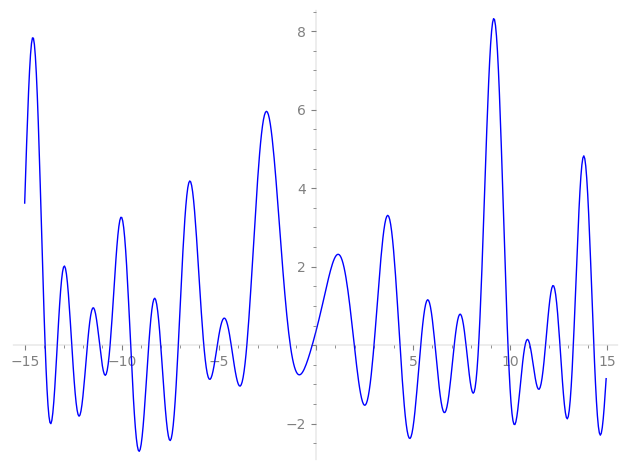| L(s) = 1 | + (−1.52 + 0.816i)3-s + (−1.82 − 3.15i)5-s + (1.58 − 2.12i)7-s + (1.66 − 2.49i)9-s + (−4.38 − 2.53i)11-s + (2.94 + 1.69i)13-s + (5.35 + 3.33i)15-s + (−0.774 − 1.34i)17-s + (0.707 + 0.408i)19-s + (−0.686 + 4.53i)21-s + (−1.47 + 0.850i)23-s + (−4.13 + 7.17i)25-s + (−0.511 + 5.17i)27-s + (−3.60 + 2.08i)29-s − 2.16i·31-s + ⋯ |
| L(s) = 1 | + (−0.881 + 0.471i)3-s + (−0.814 − 1.41i)5-s + (0.598 − 0.801i)7-s + (0.555 − 0.831i)9-s + (−1.32 − 0.763i)11-s + (0.816 + 0.471i)13-s + (1.38 + 0.860i)15-s + (−0.187 − 0.325i)17-s + (0.162 + 0.0936i)19-s + (−0.149 + 0.988i)21-s + (−0.307 + 0.177i)23-s + (−0.827 + 1.43i)25-s + (−0.0984 + 0.995i)27-s + (−0.669 + 0.386i)29-s − 0.389i·31-s + ⋯ |
\[\begin{aligned}\Lambda(s)=\mathstrut & 1008 ^{s/2} \, \Gamma_{\C}(s) \, L(s)\cr =\mathstrut & (-0.990 - 0.135i)\, \overline{\Lambda}(2-s) \end{aligned}\]
\[\begin{aligned}\Lambda(s)=\mathstrut & 1008 ^{s/2} \, \Gamma_{\C}(s+1/2) \, L(s)\cr =\mathstrut & (-0.990 - 0.135i)\, \overline{\Lambda}(1-s) \end{aligned}\]
Particular Values
| \(L(1)\) |
\(\approx\) |
\(0.3482012759\) |
| \(L(\frac12)\) |
\(\approx\) |
\(0.3482012759\) |
| \(L(\frac{3}{2})\) |
|
not available |
| \(L(1)\) |
|
not available |
\(L(s) = \displaystyle \prod_{p} F_p(p^{-s})^{-1} \)
| $p$ | $F_p(T)$ |
|---|
| bad | 2 | \( 1 \) |
| 3 | \( 1 + (1.52 - 0.816i)T \) |
| 7 | \( 1 + (-1.58 + 2.12i)T \) |
| good | 5 | \( 1 + (1.82 + 3.15i)T + (-2.5 + 4.33i)T^{2} \) |
| 11 | \( 1 + (4.38 + 2.53i)T + (5.5 + 9.52i)T^{2} \) |
| 13 | \( 1 + (-2.94 - 1.69i)T + (6.5 + 11.2i)T^{2} \) |
| 17 | \( 1 + (0.774 + 1.34i)T + (-8.5 + 14.7i)T^{2} \) |
| 19 | \( 1 + (-0.707 - 0.408i)T + (9.5 + 16.4i)T^{2} \) |
| 23 | \( 1 + (1.47 - 0.850i)T + (11.5 - 19.9i)T^{2} \) |
| 29 | \( 1 + (3.60 - 2.08i)T + (14.5 - 25.1i)T^{2} \) |
| 31 | \( 1 + 2.16iT - 31T^{2} \) |
| 37 | \( 1 + (3.39 - 5.88i)T + (-18.5 - 32.0i)T^{2} \) |
| 41 | \( 1 + (-1.01 + 1.76i)T + (-20.5 - 35.5i)T^{2} \) |
| 43 | \( 1 + (3.06 + 5.30i)T + (-21.5 + 37.2i)T^{2} \) |
| 47 | \( 1 - 6.74T + 47T^{2} \) |
| 53 | \( 1 + (11.4 - 6.63i)T + (26.5 - 45.8i)T^{2} \) |
| 59 | \( 1 - 2.17T + 59T^{2} \) |
| 61 | \( 1 + 7.25iT - 61T^{2} \) |
| 67 | \( 1 + 2.45T + 67T^{2} \) |
| 71 | \( 1 - 6.74iT - 71T^{2} \) |
| 73 | \( 1 + (-3.76 + 2.17i)T + (36.5 - 63.2i)T^{2} \) |
| 79 | \( 1 + 12.7T + 79T^{2} \) |
| 83 | \( 1 + (0.768 + 1.33i)T + (-41.5 + 71.8i)T^{2} \) |
| 89 | \( 1 + (6.01 - 10.4i)T + (-44.5 - 77.0i)T^{2} \) |
| 97 | \( 1 + (5.59 - 3.23i)T + (48.5 - 84.0i)T^{2} \) |
| show more | |
| show less | |
\(L(s) = \displaystyle\prod_p \ \prod_{j=1}^{2} (1 - \alpha_{j,p}\, p^{-s})^{-1}\)
Imaginary part of the first few zeros on the critical line
−9.540830656687128947866317919178, −8.610628385798820398843801391499, −7.993445840483166948969298632517, −7.08909277877573271172960804731, −5.77353105306570758214948136007, −5.07928245695589120508770333717, −4.36089303647912191409574920004, −3.55803078186823501153468792284, −1.31862393606902695681812425467, −0.19069735290478271632564933445,
1.97717368222187136662104086433, 2.99229396720460044860995172102, 4.33214321160066730564300292092, 5.39812980401878866907501693257, 6.13723416450958475950716254505, 7.12465876085123135847109226490, 7.73410983043744319123485303682, 8.380560394162158424768981318229, 9.893239904143676402933787697555, 10.77453802281046993341087447192

